-
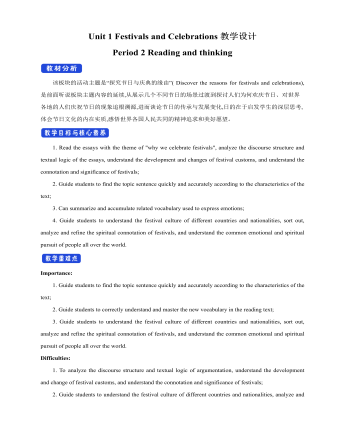
新人教版高中英语必修3Unit 1 Festivals and Celebrations教学设计三
*wide range of origins(= a great number of different origins, many kinds of origins)*It featured a parade and a great feast with music, dancing, and sports. (=A parade and a great feast with music, dancing, and sports were included as important parts of the Egyptian harvest festival.)*.. some traditions may fade away and others may be established.(= Some traditions may disappear gradually, while other new traditions may come into being.)Step 6 Practice(1) Listen and follow the tape.The teacher may remind the students to pay attention to the meaning and usage of the black words in the context, so as to prepare for the completion of the blanks in activity 5 and vocabulary exercises in the exercise book.(2) Students complete the text of activity 5 by themselves.The teacher needs to remind the students to fill in the blanks with the correct form of the vocabulary they have learned in the text.Students exchange their answers with their partners, and then teachers and students check their answers.(3)Finish the Ex in Activity 5 of students’ book.Step 7 Homework1. Read the text again, in-depth understanding of the text;2. Discuss the origin of festivals, the historical changes of related customs, the influence of commercial society on festivals and the connotation and essential meaning of festivals.3. Complete relevant exercises in the guide plan.1、通过本节内容学习,学生是否理解和掌握阅读文本中的新词汇的意义与用法;2、通过本节内容学习,学生能否结合文本特点快速而准确地找到主题句;3、通过本节内容学习,学生能否理清论说文的语篇结构和文本逻辑,了解节日风俗发展与变迁,感悟节日的内涵与意义。

新人教版高中英语必修3Unit 2 Morals and Virtues教学设计三
The joke set her crying.这个玩笑使她哭起来。Step 5 ReadingActivity 31. Students read the small text in activity 3. The teacher provides several small questions to check whether students understand the content of the text and the ideographic function of the -ing form in the text.*Where are those people?*Why did Dr Bethune come to China?*How did he help the Chinese people during the war?*What did Chairman Mao Zedong say about him?2. Ss try to rewrite some sentences using the -ing form. Then check the answers. When checking the answers, the teacher can ask different students to read the rewritten sentences and give comments.Answers:1. he became very interested in medicine, deciding to become a doctor.2. …after hearing that many people were dying in the war.3. Helping to organise hospitals, he taught doctors and nurses, and showed people how to give first aid./ He helped to organise hospitals, teaching doctors and nurses, and showing people how to give first aid.4. …praising Dr Bethune as a hero to be remembered in China.Step 6 PracticeActivity 4Students complete grammar activities 2 and 3 on page 69 of the workbook.Step 6 Homework1. Understand and master the functions and usage of the -ing form;2. Finish the other exercises in Using structures.1、通过本节内容学习,学生是否理解和掌握动词-ing形式作宾语补足语语和状语语的功能和意义;2、通过本节内容学习,学生能否正确使用动词-ing形式描述人物的行为、动作及其经历;3、通过本节内容学习,学生能否独立完成练习册和导学案中的相关练习。

新人教版高中英语必修3Unit 2 Morals and Virtues教学设计四
3.Teachers ask different groups to report the answers to the questions and ask them to try different sentence patterns.The teacher added some sentence patterns for students to refer to when writing.Step 4 Writing taskActivity 51.Write the first draft.Students first review the evaluation criteria in activity 5, and then independently complete the draft according to the outline of activity 4, the answers to the questions listed in the group discussion and report, and the reference sentence pattern.2.Change partners.The teacher guides the students to evaluate their partner's composition according to the checklist of activity 5 and proposes Suggestions for modification.3.Finalize the draft.Based on the peer evaluation, students revise their own compositions and determine the final draft.Finally, through group recommendation, the teacher selects excellent compositions for projection display or reading aloud in class, and gives comments and Suggestions.Step 5 Showing writingActivity 5T call some Ss to share their writing.Step 6 Homework1. Read the passage in this section to better understand the passage.2. Carefully understand the hierarchical structure of the article, and deeply understand the plot of the story according to the causes, process and results;3. Independently complete the relevant exercises in the guide plan.1、通过本节内容学习,学生是否理解和掌握阅读文本中的新词汇的意义与用法;2、通过本节内容学习,学生能否通过人物言行的对比分析道德故事的深层内涵;3、通过本节内容学习,学生能否根据故事的起因、经过和结果来深入理解故事的情节,从而了解文章的层次结构;4、结合现实生活案例发表自己的见解和看法,写一篇观点明确、层次分明的故事评论。

新人教版高中英语必修3Unit 2 Morals and virtues教学设计一
(2) students are divided into groups according to the requirements of activity 3. Each student shares a story of personal experience or hearing-witnessing kindness, and then selects the most touching story in the group and shares it with the whole class. Before the students share the story, the teacher can instruct them to use the words and sentence patterns in the box to express. For example, the words in the box can be classified:Time order: first of all, then, after that, later, finally logical relationship :so, however, although, butTeachers can also appropriately add some transitional language to enrich students' expression:Afterwards, afterwards, at last, in the end, eventuallySpatial order: next to, far from, on the left, in front ofOtherwise, nevertheless, as a result, therefore, furthermore, in addition, as well asSummary: in a word, in short, on the whole, to sum up, in briefStep 8 Homework1. Understand the definition of "moral dilemma" and establish a correct moral view;2. Accumulate vocabulary about attitudes and emotions in listening texts and use them to express your own views;3. Complete relevant exercises in the guide plan.1、通过本节内容学习,学生能否理解理解“道德困境”的定义;2、通过本节内容学习,学生能否通过说话人所表达的内容、说话的语气、语调等来判断其态度和情绪;3、通过本节内容学习,学生能否针对具体的道德困境发表自己的看法和见解,能否掌握听力理训练中的听力策略。

新人教版高中英语必修3Unit 3 Diverse Cultures教学设计三
The price is the same as(the price was)before the war.价格与战前相同。(4)定语从句中的“关系代词+助动词be”可以省略。The ticket(that/which was)booked by his sister has been sent to him.他妹妹订的那张票已送到了他那里。Step 5 PracticeActivity 3(1) Guide students to complete the four activities in the Using Structures part of exercise book, in which activities 1 and 2 focus on ellipsis in dialogue answers, activity 3 focus on signs and headlines, two typical situations where ellipsis is used, and activity 4 focus on ellipsis in diary, an informal style.(2) Combine the examples in the above activities, ask students to summarize the omitted situations in groups, and make their own summary into a poster, and post it on the class wall after class to share with the class.(This step should give full play to the subjectivity of students, and teachers should encourage students to conclude different ellipsis phenomena according to their own understanding, they can conclude according to the different parts omitted in the sentence.)Step 6 Homework1. Understand and master the usages of ellipsis;2. Finish the other exercises in Using structures of Workbook.1、通过本节内容学习,学生是否理解和掌握省略的用法;2、通过本节内容学习,学生能否根据上下文语境或情景恢复句子中省略的成分,体会使用省略的效果;3、通过本节内容学习,学生能否独立完成练习册和导学案中的相关练习。

新人教版高中英语必修3Unit 3 Diverse Cultures教学设计二
(2)Consolidate key vocabulary.Ask the students to complete the exercises of activity 6 by themselves. Then ask them to check the answers with their partners.(The first language:Damage of the 1906 San Francisco earthquake and fire.A second language: Yunnan - one of the most diverse provinces in China).Step 5 Language points1. The teacher asks the students to read the text carefully, find out the more words and long and difficult sentences in the text and draw lines, understand the use of vocabulary, and analyze the structure of long and difficult sentences.2. The teacher explains and summarizes the usage of core vocabulary and asks the students to take notes.3. The teacher analyzes and explains the long and difficult sentences that the students don't understand, so that the students can understand them better.Step 6 Homework1. Read the text again, in-depth understanding of the text;2. Master the use of core vocabulary and understand the long and difficult sentences.3. Complete relevant exercises in the guide plan.1、通过本节内容学习,学生是否理解和掌握阅读文本中的新词汇的意义与用法;2、通过本节内容学习,学生能否结合文本特点了解文章的结构和作者的写作逻辑;3、通过本节内容学习,学生能否了解旧金山的城市风貌、文化特色,以及加利福尼亚州的历史,体会多元文化对美国的影响。

新人教版高中英语必修3Unit 3 Diverse Cultures教学设计四
该板块的活动主题是“介绍一个有显著文化特征的地方”( Describe a place with distinctive cultural identity)。该板块通过介绍中国城继续聚焦中国文化。本单元主题图呈现的是旧金山中国城的典型景象, Reading and Thinking部分也提到中国城,为该板块作铺垫。介绍中国城的目的主要是体现中国文化与美国多元文化的关系,它是美国多元文化的重要组成部分。中国城也是海外华人的精神家园和传播中国文化的重要窗口,外国人在中国城能近距离体验中国文化。1. Read the text to understand the cultural characteristics of Chinatown in San Francisco and the relationship between Chinese culture and American multiculturalism;2. Through reading, learn to comb the main information of the article, understand the author's writing purpose and writing characteristics;3. Learn to give a comprehensive, accurate, and organized description of the city or town you live in;Learn to revise and evaluate your writing.Importance:1. Guide the students to read the introduction of Chinatown in San Francisco and grasp its writing characteristics;2. Guide students to introduce their city or town in a comprehensive, accurate and organized way;3. Learn to comb the main information of the article, understand the author's writing purpose, and master the core vocabulary.
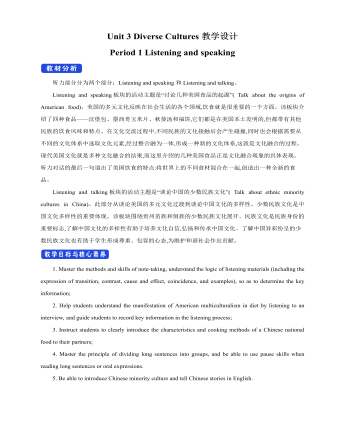
新人教版高中英语必修3Unit 3 Diverse Cultures教学设计一
Activity 81.Grasp the main idea of the listening.Listen to the tape and answer the following questions:Who are the two speakers in the listening? What is their relationship?What is the main idea of the first part of the listening? How about the second part?2.Complete the passage.Ask the students to quickly review the summaries of the two listening materials in activity 2. Then play the recording for the second time.Ask them to complete the passage and fill in the blanks.3.Play the recording again and ask the students to use the structure diagram to comb the information structure in the listening.(While listening, take notes. Capture key information quickly and accurately.)Step 8 Talking Activity 91.Focus on the listening text.Listen to the students and listen to the tape. Let them understand the attitudes of Wu Yue and Justin in the conversation.How does Wu Yue feel about Chinese minority cultures?What does Justin think of the Miao and Dong cultures?How do you know that?2.learn functional items that express concerns.Ask students to focus on the expressions listed in activity. 3.And try to analyze the meaning they convey, including praise (Super!).Agree (Exactly!)"(You're kidding.!)Tell me more about it. Tell me more about it.For example, "Yeah Sure." "Definitely!" "Certainly!" "No kidding!" "No wonder!" and so on.4.Ask the students to have conversations in small groups, acting as Jsim and his friends.Justin shares his travels in Guizhou with friends and his thoughts;Justin's friends should give appropriate feedback, express their interest in relevant information, and ask for information when necessary.In order to enrich the dialogue, teachers can expand and supplement the introduction of Miao, dong, Lusheng and Dong Dage.After the group practice, the teacher can choose several groups of students to show, and let the rest of the students listen carefully, after listening to the best performance of the group, and give at least two reasons.
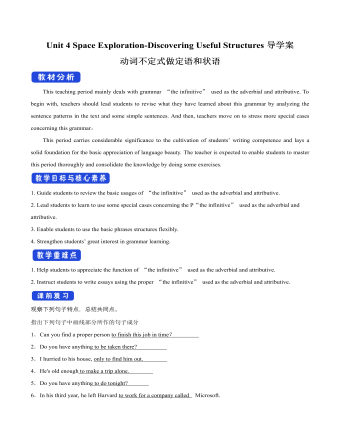
新人教版高中英语必修3Unit 4 Space Exploration-Discovering Useful Structures导学案
【点津】 1.不定式的复合结构作目的状语 ,当不定式或不定式短语有自己的执行者时,要用不定式的复合结构?即在不定式或不定式短语之前加 for +名词或宾格代词?作状语。He opened the door for the children to come in. 他开门让孩子们进来。目的状语从句与不定式的转换 英语中的目的状语从句,还可以变为不定式或不定式短语作状语,从而使句子在结构上得以简化。可分为两种情况: 1?当目的状语从句中的主语与主句中的主语相同时,可以直接简化为不定式或不定式短语作状语。We'll start early in order that/so that we may arrive in time. →We'll start early in order to/so as to arrive in time. 2?当目的状语从句中的主语与主句中的主语不相同时,要用动词不定式的复合结构作状语。I came early in order that you might read my report before the meeting. →I came early in order for you to read my report before the meeting.
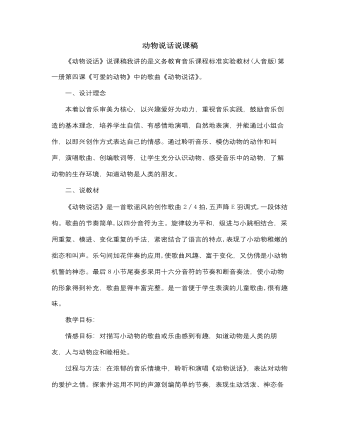
人音版小学音乐一年级上动物说话说课稿
6、总结师:听着小朋友们美妙的歌声,看着大家亲密无间的合作,老师的心里无比的快活。动物是人类的朋友,我们要保护动物,爱护动物。我想,小朋友的心情和老师心情是一样的,都很开心是吗?那么,为了表示大家高兴的心情,庆祝我们合作的愉快,我要邀请你们永远做我的朋友!(音乐起,师生一起跳舞《我们都是好朋友》)我邀请到谁,谁就可以再邀请与你合作愉快的小朋友。音乐反复到全体起立)让我们去操场邀请别的小朋友,告诉他们保护动物,爱护动物,走啦!(学生走出教室,本节教学结束)整个教学过程从一开始的律动,后来的动物模仿到创编节奏及即兴表演,运用感知法、认知法、学唱法,让学生用有感情的演唱和肢体语言表达对小动物的喜爱之情;通过创编,培养合作精神和创新能力,获得成功的喜悦。使学生的演、唱、创新、合作能力得到很好的发展,并渗透了思想教育。
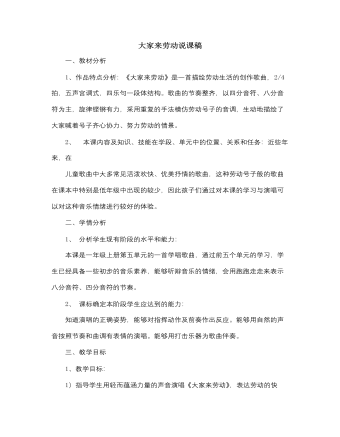
人音版小学音乐一年级上大家来劳动说课稿
2、师:"今天的音乐课上老师要带大家一起来劳动(出示课题),同学们有修桌子的叮当叮当、有擦桌子的擦擦,还有扫地的刷刷(按顺序出示节奏),让我们大家一起行动起来,加入劳动的行列。用劳动的声音来读一读,看看谁读的最准确。"(学生用劳动的声音来读的节奏实际就是歌曲的节奏,用这种方式可以让学生在潜移默化中学会歌曲中的重点节奏)[课件节奏谱]1)学生分三组按顺序读,一组读修桌子节奏,一组读擦桌子节奏,一组读扫地节奏。(这样做是为了培养学生相互配合、协作的能力)2)集体连读三、歌曲学习1、感受歌曲情绪1)师:"同学们读的很准确,反应很灵敏。看得出你们在劳动时也是非常卖力的,现在老师也想为你们这些劳动的小能手鼓劲,请你们听听老师是怎样表示的?"[课件出示前两句歌词](难点)师拿响板边拍边读:嗨哟加把劲呦,嗨哟里格嗨哟呵呵师:"刚才老师怎样为小能手加油的?"学生:嗨哟······师:你们能不能

人音版小学音乐一年级上袋鼠说课稿
设计意图:幼儿听着音乐磁带边表演边唱,把自己想象是一只小袋鼠,能用自己的动作非常投入地表演起来,这种耳闻目染的熏陶,一下子就将幼儿身心带进音乐的殿堂,群情激动,气氛达到高潮。4、感受猎人打枪及狼中枪后的游戏规则:(1)音乐结束,猎人打枪,狼倒下。(2)猎人检查狼是否死了。假如有袋鼠动了,狼就立即爬起抓住袋鼠,老师问:这只袋鼠为什么被狼抓住?(猎人开枪后,还没有检查狼是不是死了,袋鼠就动了。而这只狼很狡猾,它装死,实际上它还没有死,它看见袋鼠动了,就扑过去把它捉住了)猎人随机又开枪,将大灰狼打死。老师旁白:“狼死了没有,还不知道呢?小袋鼠可千万不能动。”猎人检查完后,说“大灰狼被打死了!”老师带领小袋鼠欢呼:“大灰狼被打死了!”,听歌曲《袋鼠》高高兴兴回家。5、幼儿完整玩游戏。进一步强调游戏规则。6、结束部分:“大灰狼被打死了!” “大灰狼被打死了!”,听歌曲《袋鼠》小袋鼠跟着妈妈高高兴兴回家。
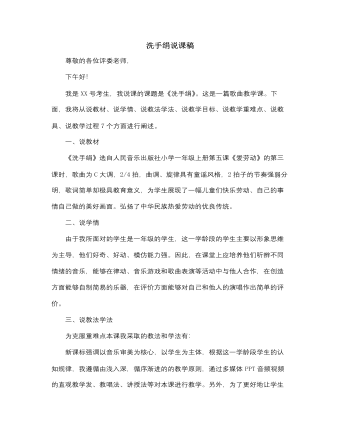
人音版小学音乐一年级上洗手绢说课稿
理论离不开实践,这个环节,为了让学生更好地体验歌曲的民谣风格,并且亲身践行自己的事情自己做和感受劳动的快乐,我将学生分成4个小组,随意解下自己的红领巾,放在讲台上事先准备的洗衣盆里清洗,并对歌词进行改编套入本曲中,边唱边洗,当唱到休止符时,要求他们做一个拧干水的动作,如:2/4 1 1 2 1 1 2 3 2 3 0: 哎 啰 哎 啰 哎 啰 哎 拧水让学生感受本曲中歌词及休止符带来的劳动感。接着,让学生对自己及他人的表现进行自评与他评,最后我来评价哪组洗的最好。让学生在做中学。最后,是我本课的教学总结本课教学,我运用了柯达伊体态律动教学法、示范法、讲授法、多媒体展示法和活动创编等方法,引导学生从多角度、多方面、多层次去体验音乐情感,通过柯达伊的律动教学,触动学生的音乐连觉反应,使其有本能的音乐反应,对学生以后形成正确的音乐学习观有着积极影响。

人音版小学音乐一年级上快乐的小笛子说课稿
9.恩,小朋友们唱得不错,但是,我觉得你们可以唱得更好!这样,小笛子和大鸭小鸭会玩得更开心!现在,脚放平,背坐直,带着愉快的心情,我们再来一次。10.今天最大的难题来了,小朋友们想不想挑战一下自己呢?好的,请你跟我这样唱,(教唱旋律,分两大组合作)11.同学们今天的表现实在是太棒了!比小笛子的歌声更美妙,更动听!老师希望我们每一位小朋友,都像快乐的小笛子一样,永远唱着快乐歌,快乐成长!让我们和小笛子一起,唱起来吧!(播放音乐,结束本课)。教学反思:快乐的小笛子是一年级上册第八课的一节唱歌课,歌曲非常欢快活泼,音乐里面加入了小鸭的叫声,非常具有童趣,学生都很感兴趣。但是这首歌曲速度比较快,很多学生一开始跟不上歌曲的节奏,显得手忙脚乱。所以我设计了吹笛子环节,让学生模仿小笛子的声音与动作,并进行形式的变化,如个人演奏、两人合奏,小组竞赛等形式,让学生非常感兴趣。学生很快就掌握了歌曲的难点,学生在快乐中学会了歌曲。
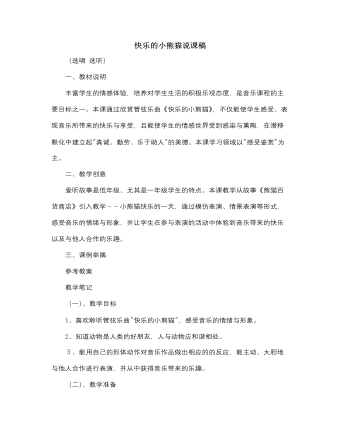
人音版小学音乐一年级上快乐的小熊猫说课稿
(时间不早了,森林里顿时热闹起来,小动物们在干什么呢?)·聆听: 听音乐第二段,感受音乐轻快的情绪。生根据自己对音乐的理解与想象回答。然后再视听结合,播放小鸟飞、在大树上叽叽喳喳的情景,进一步感受此段音乐特点,并随音乐表演。(小熊猫也出发了,看!哥弟俩抬着水桶去打水呢)。·听赏音乐第三段。感受活泼明快的"熊猫主题"。·鼓励学生模仿小熊猫打水、抬水的样子,并随音乐表演,体验音乐所表现的情绪与形象。3、完整聆听多媒体完整播放音乐及画面,学生整体感受音乐所描述的情景,同时培养学生良好的聆听音乐的习惯。4、情景表演学生选择自己喜欢的头饰,扮演动物角色,分小组随音乐进行情景表演,体验音乐带来的乐趣及与他人合作的快乐。5、评价反思、德育渗透。(四)、其他选择1、本课开始部分可用猜谜语导入。2、教师可以先让学生完整欣赏音乐,让学生根据音乐想象描述的情节,再分段欣赏。
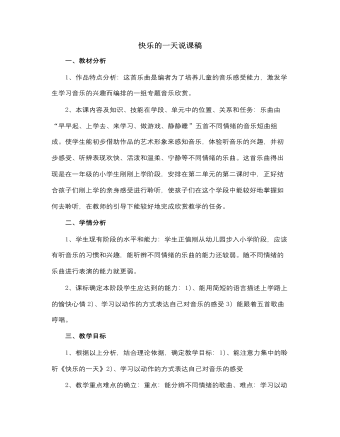
人音版小学音乐一年级上快乐的一天说课稿
课件及教具的说明:课件:教学光盘。贴纸:带不同色彩的五个小标题设计意图:教学光盘可以让小朋友清楚的聆听到五段音乐,为哼唱歌曲和表演做准备。贴纸可以一方面让学生看得更清楚;另一方面在教学中使学生们更好地为乐曲起名字打好基础。六、教学反思1、重点及难点的解决效果:本课重难点解决较好,学生能分辨不同情绪的乐曲,随音乐表演在教师的指导下有了较大的进步。2、本课成功之处:(1)学生参与的积极性很高(2)特别喜欢随音乐表演,表演能力有了较大的提高。(3)能分辨不同情绪的乐曲,还能较准确的起名字,学生对音乐欣赏产生了浓厚的兴趣。3、本课失败之处:个别同学表现有难度,教师还要加强指导4、生成问题:学生在起名字和表演时都出现了较好的创编5、今后调整思路:一方面老师要加强自身业务水平的提高,另一方面在随音乐表演的环节还要加强指导。
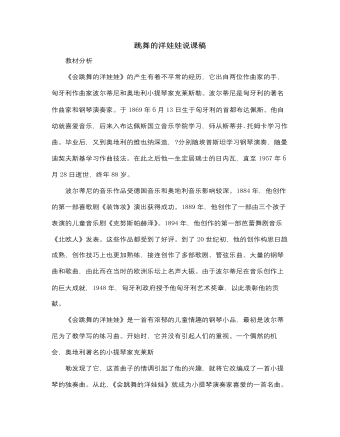
人音版小学音乐一年级上跳舞的洋娃娃说课稿
乐曲是三部曲式,D大调,3/8拍,快板。乐曲开始是一个短小的引子,由钢琴演奏。前面的5小节之后,小提琴从弱拍进入,用弹跳式的弓法演奏,由这里开始的一系列16分音符和8分音符,都加有顿音记号,取得了绝妙的效果,把洋娃娃那可爱、活泼,又有几分笨拙、机械的动作描绘得活灵活现。B段转A大调。曲调优美、婉转,在性格上它与A段形成鲜明的对比。后半部分在调性上做文章,使乐曲产生了色彩斑斓的效果:然后A段再现,最后轻快地结束全曲。学生会很喜欢这首小曲,从中感受小提琴的音色,感受乐曲活泼欢快与优美抒情的对比。 聆听《会跳舞的洋娃娃》教学基本要求1.完整聆听乐曲,感受乐曲的情绪。2.乐曲是由什么乐器演奏的?乐曲的洋娃娃怎样跳舞,请你用动作表现出来。3.复听乐曲,一部分同学随着音乐做动作。用手半握拳敲击节拍。一部分学生可随着音乐用手指按图谱划动,感受乐曲的快慢。

人音版小学音乐一年级上拉勾勾说课稿
三、创造表现:1、边唱边表演(自由结合小组),分组站成圆圈并拍手做动作演唱歌曲《拉勾勾》。2、组织游戏,不要求动作统一,提倡学生自编自演,总结哪一组表演好哪一组演唱好并评奖。四、完美结课:教师发奖总结同学们应团结友爱和每个人都应成为好朋友教学点评:在本课教学中我设计了游戏《拉勾勾、找朋友》紧密结合了本课教学内容,将音乐教学巧妙地溶合进游戏中,让学生在游戏中学习感觉理解音乐,激发学生团结友爱的情感,调动了学生学习的积极、主动性,课堂效果很好!通过创设情境和让学生画头饰等教学手段将学生融入音乐内容之中,从而更好地理解感受乐曲所表现的内容,通过本课教学,今后更应重视对学生能力的培养,如表现音乐、即兴创造等能力。让学生在理解音乐的基础上对音乐有自己的感受和评判,不限制学生对音乐的想象,充分保护学生的想象空间,使学生充分发挥想象力提高理解、感受音乐能力。
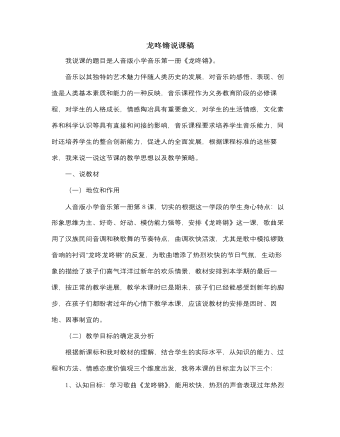
人音版小学音乐一年级上龙咚锵说课稿
五、教学特色(总结以上过程和策略,我认为我的教学特色是)1、面向全体学生,突出学科特点。2、创造合作互动,尊重独特体验。3、运用现代手段,实现学科整合。六、板书设计我采用了图文式板书——清晰明了,具有艺术性、启发性,将难点进行突破,形象生动,让学生一目了然。七、教学启示总之,本方案设计,力求体现以人为本的思想,着眼于学生的主动发展,致力于运用现代信息技术优化课堂教学,通过充分的音乐实践培养学生的能力,提高音乐素养,依托音乐本身的魅力,影响学生人生观、审美观、价值观的形成,培养学生主动学习、合作意识,探究精神,从目标的提出到过程的安排,学习方法的确定,乃至学习成果的呈现都让学生有更大的自主性,更多的实践性,更浓的创造性,当然,措施付诸实施,还需要老师的爱心和慧心,教学研究永无止境,我相信,没有最好,只有更好,在此,还请各位老师和同行们提出宝贵意见,谢谢!
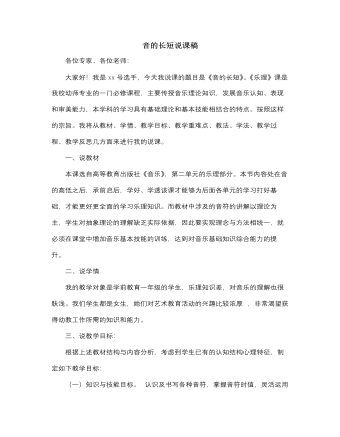
人音版小学音乐一年级上音的长短说课稿
第五个环节:最后播放一段音画视频,儿童舞蹈《数鸭子》,让全体同学跟着音乐哼唱儿歌,让她们感觉回到了自己的童年时代。让学生即兴创编舞蹈动作,并上台表演。这样,使学生在律动中获得身心愉悦,把整节课堂气氛推向了高潮。并在欢乐的歌舞声中结束。接下来说说我的作业布置情况: 1、知识巩固性的作业,做练习题书中P37页第一题,第二题。2、拓展性作业,收集儿歌《》《》《》并找出音符在其乐曲中的长短。七、板书设计(一)黑板中央上方写上题目——音的长短。(二)左上方依次写下单纯音符、几种常见音符及其形状。(三)画出各音符之间的时值比例关系图。(四)右边画出音符及其时值和单位拍的对照表。八、教学反思最后我就说说教学反思,本节课的教学围绕着学生想、听、唱、跳这样的动作层层推进。调动了学生的学习热情,关注学生的个性发展。激发了学生学习音乐的兴趣,增强她们的基本技能,为以后从事幼教工作打下坚定的基础。最后以一句歌词,来结束我的说课。

